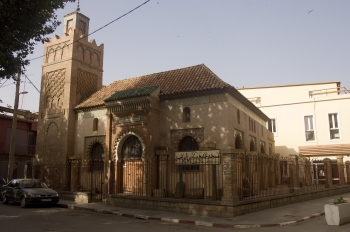
The Abdelwadids (1236-1554) Kingdom of Tlemcen

The dynasty continued to survive but with difficulty, resisting Marinid and Hafsid attempts at expansion (in the fifteenth century), and without managing to establish a strong central power, or defeating internal tribal disagreements.
Abdalwadid art has left us some modest works, mainly located in the capital Tlemcen. Several oratories were built, mainly near the mausoleums of holy people. Both the Sidi Abu l-Hasan mosque, dedicated to a scholar from Tenes and founded in 1296, and the Awlad al-Imam mosque (1310), are small in size and have no central courtyard. The prayer hall is composed of naves running perpendicular to the qibla. The Sidi Brahim mosque, built under Abu Hammu II, follows a similar lay out to the two previous mosques, but with a central courtyard surrounded by a gallery, extending the prayer hall naves. The mihrâb is preceded by a ribbed dome. The buildings are covered in wooden roof structures, sometimes arranged, as is the case at the Sidi Abu l-Hasan oratory, according to the Andalusian techniques of artesonados ceilings.
The Abdalwadids did not build many new mosques, but they did carefully maintain, restore, and extend pre-existing buildings. Therefore, several mosques in Zayyanid territory have minarets. We probably owe the minarets of the two mosques in Tlemcen - the Great Mosque and that of Agadir - to Yaghmurasan. In both cases, the minarets were built on the Almohad model, the prototype of which is the minaret of the Qasba mosque in Marrakech. The quadrangular towers are topped with a lantern, and decorations sculpted on their brick portray the diamond-shaped tracery that decorates the body of the minaret. The presence of a panel of diamond-shaped tracery can be seen elsewhere, such as in Nedroma, or on the minarets of the Abû l-Hasan and Sidi Ibrahim oratories in Tlemcen. The diamond-shaped tracery, a typical hallmark of Almohad decorative heritage, is however, absent from the minarets of the Awlad al-Imam and Mechouar mosques in Tlemcen, on which the facades of the towers are decorated with a rectangular panel featuring interlaced arches.
The Abdalwadid sovereigns built several madrasas, all of which have now unfortunately disappeared. The first was built under Abû Hammû Ist who, towards 1310, ordered the construction of the madrasa of the Awlad al-Imam, in honour of two scholars from the region of Tenes. Towards 1327, the al-Tashfiniyya was built, by Abu Tashfîn, and was located in the immediate vicinity of the Great Mosque of Tlemcen. Restored several times, in particular in the fifteenth century, during the reign of Abu l-Abbas b. Musa (r.1430-1461), it was demolished in 1873 for the construction of the town hall. We have evidence of its layout and several fragments of its decoration – the monument is planned around two perpendicular axes, one linking the stately entrances, and the other, crossing the prayer hall mihrâb.
The central courtyard, which is rectangular in form, is entirely surrounded by galleries. The prayer hall features an original layout – it is accessed by a gallery decorated with a basin. Inside, the oratory is divided into three parts – a central section covered by a dome, bordered on either side by rectangular areas – one of the two side sections may have been used for funerary purposes. A final Zayyanid madrasa, al-Ya‘qûbiyya, was built under the reign of Abû Hammû II.
As well as the development of saint-worship, post-Almohad Maghrebin architecture was characterised by an interest in funerary buildings. Some funerary qubbas from the Abdelwadid period remain. The Sidi Marzuq qubba, probably dating from the reign of Yaghmurâsan, is located on the south-west corner of the Great Mosque of Tlemcen. The mausoleum is reached via an antechamber, and the funerary area itself is covered by an eight-sided dome. The Sidi Ibrahim qubba, built by Abu Hammu II, is reached by an open-air courtyard. The funerary chamber, also topped by an eight-sided dome, is richly decorated with panels of sculpted plaster containing lengthy inscriptions from the Koran.
The end of the Abdalwadid dynasty was as eventful as its first century of history. Weakened by internal disagreements and the strong hold of the nomadic Arab tribes, the Abdalwadids were reduced to the suzerainty of the Spanish of Oran (1509), then the Turks of Algiers (1517). Subjected to Saadian rule for a while, Tlemcen was definitively occupied by the Turks in 1550, thus putting an end to Abdelwadid power for once and for all.
Y.B
Posté Le : 08/12/2019
Posté par : tlemcen2011
Source : http://www.qantara-med.org/qantara4/public/show_document.php?do_id=603&lang=en